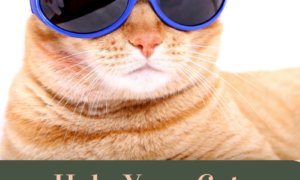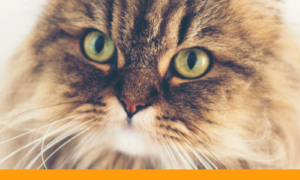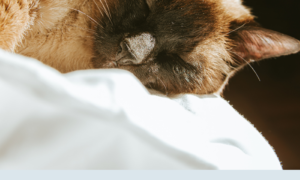Now I ask you…is your cat fat? Unfortunately, overweight cats are becoming far too common. Recent research from The Association for Pet Obesity Prevention (APOP) shows that 58 percent of American cats are overweight, and 28 percent are considered obese.
Before determining a course of action, speak with your veterinarian to rule out any potential underlying causes that might be attributed to your cat’s weight increase. Your vet can help you put together a sensible weight loss, diet and exercise plan.
Determining Overweight Cats
According to pets.webmd.com, the average domestic shorthair cat should weigh between eight and ten pounds.
To determine if your cat is overweight:
- Gently squeeze the sides of his rib cage. If you can easily feel his ribs, he is most likely not overweight. If you have to press to get to the ribs, then there may be some added weight there.
- Next, look at his waistline. His body should become slenderer from the belly to the rear.
- Also, a swinging pouch between your cat’s hind legs is a strong indicator of excess weight.
Weight Loss Tips For Overweight Cats
So, how do you go about slimming down your cat? There are a few basic suggestions that will get the ball rolling in terms of limiting calories and getting that trimmer figure he needs:
- Measure out his food. Divide his targeted caloric intake into four to six smaller meals throughout the day.
- Keep his water bowl full. The more water he consumes, the fuller he will feel and therefore will be less likely to chow down.
- Leave his food out for a limited amount of time.
- Set a weight loss goal with your vet.
- Don’t be the treat queen or king. And if you feel you just have to give your cat a treat, use a few pieces of his dry food as a substitute.
- Resist the urge to share your food with your cat. Not only will it continue to fatten him up, it can also cause diarrhea.
- Incorporate more physical activity into your cat’s lifestyle. Unfortunately, if this was not introduced to your cat when he was younger, it can be more of a challenge when he is older. Interactive wand toys and treat/food dispensing toys, are great to get your cat moving. Climbing structures, scratching posts and empty boxes make great workout equipment, too.
Dietary Changes For Overweight Cats
When changing your cat’s diet, it is important to do this slowly. The best thing to do is to cut calories in his diet in direct proportion to the amount of work the cat is doing. The Association for Pet Obesity Preventions (APOP) indicates that a loss of about one pound per month is healthy.
So…. what is the best cat diet to implement? Well, there are several dry and wet foods that your cat will still enjoy and that are full of the nutrients he needs.
Read the labels on the cans, since it is important to reduce the fat content and replace it with more protein and carbohydrates. Fat is the biggest contributor to the amount of calories!
Check labels on cat food, looking for nutrients such as taurine and B vitamins and speak with your vet about which nutrients your cat needs for his particular stage in life.
If you don’t see results after pursuing these measures, then speak with your vet. Sometimes, your cat still may be eating too much and you might not even realize it.
For more info on helping your cat get more exercise, check out this post http://bit.ly/1GfjKHe







